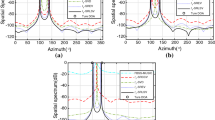Abstract
This paper discusses the problem of two-dimensional direction of arrival estimation of coherent sources for acoustic vector sensors array. Compared with subspace-based methods, such as root multiple signal classification and estimation of signal parameters via rotational invariance technique, the propagator method (PM) has lower computational complexity. However, only in high-snapshots situation, can the PM algorithm enjoy a better estimation performance. Besides, all of these algorithms mentioned above cannot work for coherent sources. In this paper, we combine PM algorithm with Toeplitz Hermitian matrix reconstruction, and propose an improved algorithm, which works well in the case of coherent signals and a single snapshot. Furthermore, the proposed method can achieve automatically paired two-dimensional angle estimation. Simulation results verify that the proposed method has the better angle performance and less computational complexity than spatial smoothing methods.









Similar content being viewed by others
References
Sun, G., Li, Q., & Zhang, B. (2006). Acoustic vector sensor signal processing. Chinese Journal of Acoustics, 25(1), 1–15.
Nehorai, A., & Paldi, E. (1994). Acoustic vector-sensor array processing. IEEE Transcations on Signal Processing, 42(9), 2481–2491.
Sun, G., Yang, D., & Zhang, L. (2003). Maximum likelihood ratio detection and maximum likelihood DOA estimation based on the vector hydrophone. Acta Acustica, 28(1), 66–72.
Hawkes, M., & Nehorai, A. (1998). Acoustic vector-sensor beamforming and Capon direction estimation. IEEE Transcations Signal Processing, 46(9), 2291–2304.
Chen, H., & Zhao, J. (2004). Wideband MVDR beamforming for acoustic vector sensor linear array. IEE Proceedings Radar Sonar and Navigatation, 151(3), 158–162.
Hochwald, B., & Nehorai, A. (1996). Identifiability in array processing models with vector-sensor applications. IEEE Transcations on Signal Processing, 44(1), 83–95.
Wong, K. T., & Zoltowski, M. D. (1997). Closed-form underwater acoustic direction-finding with arbitrarily spaced vector hydrophones at unknown locations. IEEE Journal of Oceanic Engineering, 22(3), 566–575.
Wong, K. T., & Zoltowski, M. D. (1997). Extended-Aperture underwater acoustic multisource azimuth/elevation direction-finding using uniformly but sparsely spaced vector hydrophones. IEEE Journal of Oceanic Engneering, 22(4), 659–672.
He, J., Jiang, S., Wang, J., & Liu, Z. (2009). Direction finding in spatially correlated noise fields with arbitrarily-spaced and far-separated subarrays at unknown locations. IET Radar Sonar and Navigatation, 3(3), 278–284.
Wong, K. T., & Zoltowski, M. D. (1999). Root-MUSIC-based azimuth-elevation angle-of-arrival Estimation with uniformly spaced but arbitrarily oriented velocity hydrophones. IEEE Transcations on Signal Processing, 47(12), 3250–3260.
Wong, K. T., & Zoltowski, M. D. (2000). Self-initiating MUSIC-based direction finding in underwater acoustic particle velocity-field beamspace. IEEE Journal of Oceanic Engineering, 25(2), 262–273.
Wang, Y., Zhang, J., Hu, B., & He, J. (2008). Hypercomplex model of acoustic vector sensor array with its application for the high resolution two dimensional direction of arrival estimation. In Proceedings of IEEE instrumentation & measurement technol. conference (IMTC’ 2008), Victoria, BC. May, 1–5.
Yuan, Y., Zhang, B., Fan, D., & Tong, G. (September 2008). DFT and PSD for estimating DOA with an active acoustic array. In IEEE international conference automation and logistics (ICAL’ 2008) (pp. 694–699).
Arunkumar, K. P., & Anand, G. V. (2007). Multiple source localization in shallow ocean using a uniform linear horizontal array of acoustic vector sensors. In 2007 IEEE intelligent information communication technologies for better human life (TENCON 2007), Taibei. China, 2007 (pp. 1–4).
Tam, P. K., & Wong, K. T. (2009). Cramer-Rao bounds for direction finding by an acoustic vector sensor under nonideal gain-phase responses. IEEE Sensors Journal, 9(8), 969–982.
Abdi, A., & Guo, H. (2009). Signal correlation modeling in acoustic vector sensor arrays. IEEE Transcations on Signal Processing, 57(3), 892–903.
Hawkes, M., & Nehorai, A. (2003). Wideband source localization using a distributed acoustic vector-sensor array. IEEE Transcations on Signal Processing, 51(6), 1479–1491.
Nan, Z., Swee, C. C., & Chew, B. A. L. (2006). Vector hydrophone array development and its associated DOA estimation algorithms. In Asia Pacific OCEANS, May, 2007 (pp. 1–5).
Pillai, S. U., & Kwon, B. H. (1989). Forward/backward smoothing techniques for coherent signal identification. IEEE Transcations on Acoustics Speech Signal Processing, 37(1), 8–15.
Zhang, X., Wang, F., & Xu, D. (2010). Array signal processing theory and applications [M], Vol. 11. Beijing: National Defense Industry Press (pp. 15–18) (77–128).
Liu, C., Zhao, Y., & Hu, D. (2010). High resolution algorithm for direction of arrival estimation based on modified propagator method. Journal of Computer Applications, 30(5):1418–1421.
He, J., & Liu, Z. (2009). Efficient underwater two-dimensional coherent source localization with linear vector-hydrophone array. Signal Processing, 89, 1715–1722.
Palanisamy, P., Kalyanasundaram, N., & Swetha, P. M. (2012). Two-dimensional DOA estimation of coherent signals using acoustic vector sensor array. Signal Processing, 92, 19–28.
Acknowledgments
This work is supported by China NSF Grants (60801052), Jiangsu Planned Projects for Postdoctoral Research Funds (1201039C), China Postdoctoral Science Foundation (2012M521099), Open project of key laboratory of underwater acoustic communication and marine information technology (Xiamen University), Hubei Key Laboratory of Intelligent Wire1ess Communications (IWC2012002), Open project of Key Laboratory of Nondestructive Testing (Nanchang Hangkong University), Open project of Key Laboratory of modern acoustic of Ministry of Education (Nanjing University), the Aeronautical Science Foundation of China (20120152001), and the Fundamental Research Funds for the Central Universities (NZ2012010, kfjj120115, kfjj20110215).
Author information
Authors and Affiliations
Corresponding author
Rights and permissions
About this article
Cite this article
Chen, H., Zhang, X. Two-Dimensional DOA Estimation of Coherent Sources for Acoustic Vector-Sensor Array Using a Single Snapshot. Wireless Pers Commun 72, 1–13 (2013). https://doi.org/10.1007/s11277-013-0997-z
Published:
Issue Date:
DOI: https://doi.org/10.1007/s11277-013-0997-z




